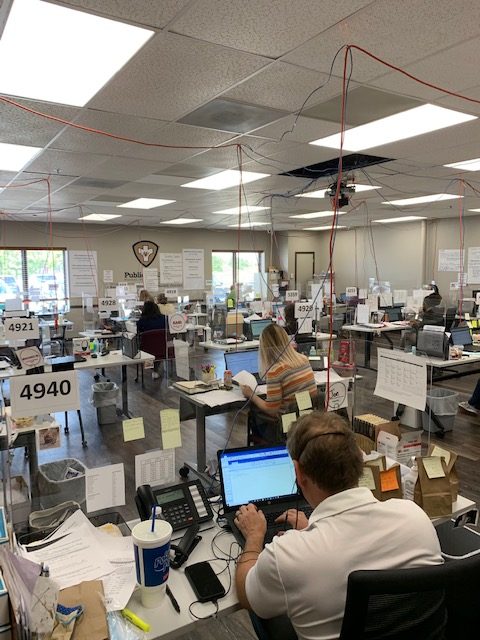Contact tracers weigh tradeoffs of privacy, public health
Photo Courtesy of Champaign-Urbana Public Health District
Employees work at their computers in the Champaign-Urbana Public Health District’s operations center. CUPHD conducts the vast majority of contact tracing in the area.
February 25, 2021
Contact tracing has undergone a transformation from being a relatively unknown process to becoming a household term during the pandemic. However, the way the vast majority of American public health departments conduct contact tracing has remained the same.
Junghwan Kim, graduate student in LAS, recently published a research survey that offers an explanation as to why American public health departments have used the same method of contact tracing, despite growing research that suggests other methods may be more beneficial to public health.
Published in the International Journal of Geo-Information, Kim’s research investigated how willing people are to accept various COVID-19 mitigation measures that harness people’s location information. The survey measured individual’s attitudes toward digital contact tracing measures such as GPS tracking and wearing an eletronic-wristband to monitor self-quarantine.
The survey, which recruited participants through social media and contains a sample slightly younger and higher-educated than the general population, focused on two countries: South Korea and the United States.
“The research indicates that people in South Korea are more willing to accept those COVID-19 mitigation measures harnessing sensitive geospatial data, and there is some kind of tradeoff relationship between privacy concerns and social benefits,” Kim said. “If a person has a lower privacy concern and higher social-benefits, then that person is likely to accept those COVID-19 measures.”
Get The Daily Illini in your inbox!
The contact tracing method used in the United States, which Kim refers to as the “traditional method,” utilizes a team of contact tracers getting in contact with the COVID-19-positive individual, asking questions about who they’ve been in contact with, and subsequently notifying the mentioned contacts. However, in addition to the “traditional method,” health departments in South Korea have utilized GPS data, credit card transactions and closed-circuit television recordings to make contact tracing more efficient.
“The ‘traditional method,’ with the one-to-one interviews, may have some limitations,” Kim said. “It’s time-costly because you need to do the interview one by one. In South Korea, the traditional method is also used, but if the interview is impossible or the information seems a little bit invalid, then they request those kinds of additional information through the legal way, then access that information to increase the validity of the contact tracing.”
Within the Champaign-Urbana community, two different methods of contact tracing are used. The Champaign-Urbana Public Health District, which conducts the vast majority of contact tracing in the area, utilizes the “traditional method.”
Nancy Johnson works as an operational lead for the emergency operations center at CUPHD and oversees CUPHD’s contact tracing department. Working off the “traditional method,” CUPHD’s team of 20-35 contact tracers reach out by phone to notify an individual they’ve tested positive for COVID-19, ask questions about who they’ve come in contact with and notify those contacts.
Johnson noted that CUPHD’s contact tracing program reaches out personally to clarify any questions community members may have.
“(The main benefit of our contact tracing program is) that we reach out to people personally,” Johnson said. “I know there are some areas that are just doing by-mail notification, or a robo-message by phone, and while that’s great for notifying people they’ve been exposed to, it’s not offering them all the services or answering all their questions. It’s making it harder for them, making it so they have to call and try to figure out who to call to ask questions. I feel like when we call people, it gives them the opportunity to talk it out with someone.”
According to Johnson, the approximate time it takes from when an individual tests positive for COVID-19, to when their contacts have been notified, is “less than 12 hours.”
Students and faculty at the University have another option that bridges the gap between privacy and public health through the Safer Illinois App.
When signing up for the Safer Illinois App, users can enable exposure notifications. When enabled, the Safer Illinois app uses Bluetooth data to record how long an individual has been in proximity to another individual with the app. If an individual tests positive for COVID-19, anyone with exposure notifications on who was within 10 feet of the positive individual for two continuous hours will be notified through the app.
According to the Safer Illinois app’s information page, the app does not collect location data such as GPS position, only the Bluetooth data that gets shared when two phones are in close physical proximity of each other. While Kim believes the Bluetooth contact tracing option offered by Safer Illinois effectively balances privacy and societal benefit, he doesn’t know if enough people utilize the app to make it effective.
“Since the app allows for people to freely opt out of the Bluetooth option, I think it’ll be OK in terms of the privacy aspect, because if a person feels uncomfortable, then they can easily and freely opt out of using that feature,” Kim said. “Based on modeling epidemiologists have created, at least 50% or 60% need to use that Bluetooth feature, to reasonably control the pandemic in a given area. But I think that it’s not the case here because I do not know the data about how the percentage of University members who use that feature.”







